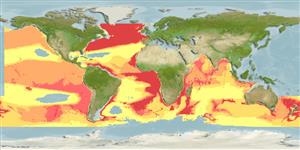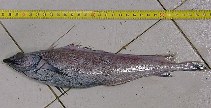Add your observation in Fish Watcher
| Native range | All suitable habitat | Point map | Year 2050 |

|
| This map was computer-generated and has not yet been reviewed. |
| Antimora rostrata AquaMaps Data sources: GBIF OBIS |
Upload your photos and videos
Pictures | Videos | Google imageAntimora rostrata
Picture by Garazo Fabregat, A.
Pictures | Videos | Google imageAntimora rostrata
Picture by Garazo Fabregat, A.
Argentina country information
Common names:
[No common name]
Occurrence: native
Salinity: marine
Abundance: | Ref:
Importance: | Ref:
Aquaculture: | Ref:
Regulations: | Ref:
Uses: no uses
Comments: Occurs in the Patagonian region (Ref. 27363). Also Ref. 3917.
National Checklist: Argentina
Country Information: https://www.cia.gov/library/publications/resources/the-world-factbook/geos/ar.html
National Fisheries Authority:
Occurrences: Occurrences Point map
Main Ref: Cohen, D.M., T. Inada, T. Iwamoto and N. Scialabba, 1990
National Database:
Occurrence: native
Salinity: marine
Abundance: | Ref:
Importance: | Ref:
Aquaculture: | Ref:
Regulations: | Ref:
Uses: no uses
Comments: Occurs in the Patagonian region (Ref. 27363). Also Ref. 3917.
National Checklist: Argentina
Country Information: https://www.cia.gov/library/publications/resources/the-world-factbook/geos/ar.html
National Fisheries Authority:
Occurrences: Occurrences Point map
Main Ref: Cohen, D.M., T. Inada, T. Iwamoto and N. Scialabba, 1990
National Database:
Common names from other countries
Classification / Names Nomi Comuni | Sinonimi | Catalog of Fishes(Genere, Specie) | ITIS | CoL | WoRMS | Cloffa
Environment: milieu / climate zone / depth range / distribution range Ecologia
marino batipelagico; distribuzione batimetrica 350 - 3000 m (Ref. 1371), usually 1200 - 2700 m (Ref. 5951). Deep-water; 70°N - 68°S, 180°W - 180°E
Distribuzione Stati | Aree FAO | Ecosystems | Presenze | Point map | Introduzioni | Faunafri
Circumglobal: Except the North Pacific north of 10°N. Reported from the Walvis Ridge and near the Discovery and Meteor seamounts (Ref. 44938).
Length at first maturity / Size / Peso / Age
Maturity: Lm 42.0, range 41 - 43 cm
Max length : 75.0 cm SL maschio/sesso non determinato; (Ref. 5208); peso massimo pubblicato: 3.3 kg (Ref. 128737); peso massimo pubblicato: 3.3 kg; Età massima riportata: 44 anni (Ref. 128738)
Max length : 75.0 cm SL maschio/sesso non determinato; (Ref. 5208); peso massimo pubblicato: 3.3 kg (Ref. 128737); peso massimo pubblicato: 3.3 kg; Età massima riportata: 44 anni (Ref. 128738)
Short description Chiavi di identificazione | Morfologia | Morfometria
Spine dorsali (totale) : 0; Raggi dorsali molli (totale) : 55 - 61; Spine anali: 0; Raggi anali molli: 36 - 44; Vertebre: 57 - 60. Blue-grey to blackish (Ref. 6606).
Found on the continental slope and upper rise (Ref. 6606). Epibenthic (Ref. 58426) and benthopelagic (Ref. 5951). Deep waters to 3277 m (Ref. 58426). May move offshore with age and spawn in the deep parts of its range. Off the eastern coast of United States, it is speculated that the population use the area only as feeding grounds with spawning taking place to the north. Feed on benthic invertebrates (Ref. 9319). Maximum weight of female from Ref. 128738.
Life cycle and mating behavior Maturità | Riproduzione | Deposizione | Uova | Fecundity | Larve
Main reference
Upload your references | Bibliografia | Coordinatore | Collaboratori
Cohen, D.M., T. Inada, T. Iwamoto and N. Scialabba, 1990. FAO species catalogue. Vol. 10. Gadiform fishes of the world (Order Gadiformes). An annotated and illustrated catalogue of cods, hakes, grenadiers and other gadiform fishes known to date. FAO Fish. Synop. 125(10). Rome: FAO. 442 p. (Ref. 1371)
Threat to humans
Harmless
Human uses
Pesca: commerciale
FAO(pesca: production; publication : search) | FIRMS (Stock assessments) | FishSource | Sea Around Us
Informazioni ulteriori
Population dynamics
Growth parameters
Max. ages / sizes
Length-weight rel.
Length-length rel.
Length-frequencies
Mass conversion
Reclutamento
Abbondanza
Growth parameters
Max. ages / sizes
Length-weight rel.
Length-length rel.
Length-frequencies
Mass conversion
Reclutamento
Abbondanza
Life cycle
Riproduzione
Maturità
Fecundity
Deposizione
Spawning aggregations
Uova
Egg development
Larve
Dinamica popolazioni larvali
Riproduzione
Maturità
Fecundity
Deposizione
Spawning aggregations
Uova
Egg development
Larve
Dinamica popolazioni larvali
Anatomy
Area branchiale
Brain
Otolith
Area branchiale
Brain
Otolith
Physiology
Body composition
Nutrients
Oxygen consumption
Swimming type
Swimming speed
Visual pigments
Fish sound
Diseases & Parasites
Toxicity (LC50s)
Body composition
Nutrients
Oxygen consumption
Swimming type
Swimming speed
Visual pigments
Fish sound
Diseases & Parasites
Toxicity (LC50s)
Genetics
Genetica
Heterozygosity
Ereditarietà
Genetica
Heterozygosity
Ereditarietà
Human related
Aquaculture systems
Profili di acquacoltura
Varietà
Ciguatera cases
Stamps, coins, misc.
Aquaculture systems
Profili di acquacoltura
Varietà
Ciguatera cases
Stamps, coins, misc.
Strumenti
E-book | Giuda pratica | Chiavi di identificazione | Generatore frequenze di lunghezza | Strumento Parametri Biologici | Mappa dei ritrovamenti | Classification Tree
| Catch-MSY |
Special reports
Download XML
Fonti Internet
Aquatic Commons | BHL | Cloffa | BOLDSystems | Websites from users | Check FishWatcher | CISTI | Catalog of Fishes(Genere, Specie) | DiscoverLife | ECOTOX | Faunafri | Fishtrace | GenBank(genome, nucleotide) | GloBI | GOBASE | | Google Books | Google Scholar | Google | IGFA World Record | MitoFish | Database Nazionali | Otolith Atlas of Taiwan Fishes | PubMed | Reef Life Survey | Scirus | SeaLifeBase | Tree of Life | Wikipedia(Go, ricerca) | World Records Freshwater Fishing | Zoological Record
Estimates based on models
Preferred temperature (Ref. 115969): 1.9 - 4.6, mean 2.9 (based on 4347 cells).
Phylogenetic diversity index (Ref. 82804): PD50 = 0.7500 [Uniqueness, from 0.5 = low to 2.0 = high].
Bayesian length-weight: a=0.00331 (0.00267 - 0.00411), b=3.15 (3.08 - 3.22), in cm Total Length, based on LWR estimates for this species (Ref. 93245).
Trophic level (Ref. 69278): 3.6 ±0.47 se; based on food items.
Resilienza (Ref. 120179): Molto basso, tempo minimo di raddoppiamento della popolazione più di 14 anni (K=0.05-1.0; tm=15; tmax=44).
Fishing Vulnerability (Ref. 59153): High to very high vulnerability (70 of 100).
Climate Vulnerability (Ref. 125649): Moderate vulnerability (38 of 100).




